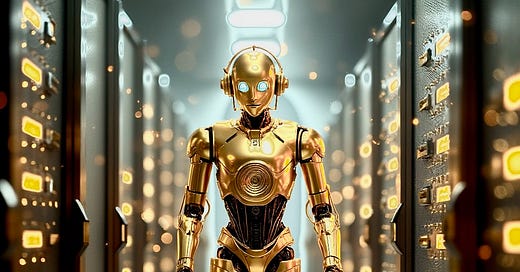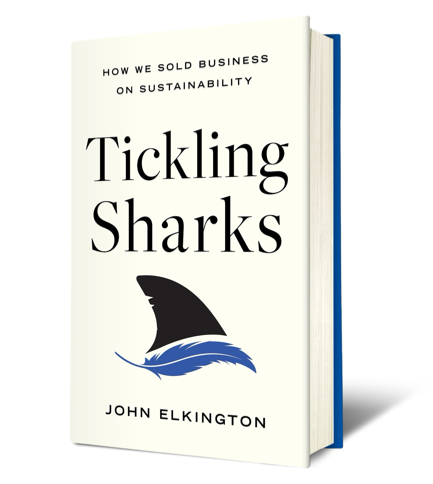Can A.I. Become Sustainable?
Not on current trends, says a new white paper from Generation Investment Management
Every time I use AI to generate images for these posts, I am acutely aware of the energy used by the data centers generating them—and the linked GHG emissions.
Not so long ago one could assume that the cloud and data giants involved were moving toward renewable energy. But then we heard about the growing energy demand of data their centers, with key players like Microsoft even exploring the nuclear option—in their case trying to revive the Three Mile Island reactors to power their data centers.
So how sustainable is AI going to be?
Hungrier for power
This question is raised by a new white paper from Generation Investment Management which, cutting directly to the chase, is titled Is AI Sustainable? Its conclusions are pretty worrying. As Generation explains:
Data centres already use a lot of energy. In combination with data transmission networks, they now account for 1-2% of energy-related greenhouse-gas emissions. As AI has become more clever, it has become hungrier for power. According to one estimate, OpenAI’s GPT-4 required 50 gigawatt hours (GWh) of electricity to train—roughly the annual consumption of a small city.
Once AI models are trained, they then require power to be used in real-world applications (so-called ‘inference’). It is harder to measure the power demands of inference “largely due to its distributed nature, compared with the relatively time- and location-constrained nature of training.” But the academic evidence suggests the energy demands of inference increase with the size of the AI model. The most energy-intensive tasks are those which generate new content, such as text or images, as the graph below illustrates.

Back to fossil fuels?
According to the International Energy Agency (IEA), AI-related energy demand is set to almost double between 2022 and 2026. Bad enough, but Generation is more pessimistic still. “There are … forecasts that are much more drastic,” it concludes. “It is easy to imagine a world in which ever more sophisticated AI causes global energy demand to soar, which in turn raises carbon emissions.”
One possibility is that cloud companies decide to meet the demands of generative AI by moving back to fossil fuels. “Fossil fuels could provide a steady, 'behind-the-meter' (i.e., off-grid) supply of energy for data centres,” Generation warns.
Experts we have spoken to suggest that to meet the extra energy demand, we might have to keep old gas- or coal-power plants running longer, or even build new ones. Already there are anecdotes of this happening. That is deeply concerning. Just as the world needs to make progress on cutting carbon emissions, we risk going backwards.
Ultimately, the white paper concludes, “there is great uncertainty about whether AI will prove to be sustainable or not.”
So, who must do what?
Cloud companies now have a grave responsibility, Generation insists. “They have real agency here—not only to participate in the buildout of the grid, but also to reward, punish and lobby governments which help or hinder the rollout of renewables and grid reform.”
Then the sting in the tail. “As sustainable investors,” runs the white paper’s last line, “we will rigorously hold them accountable.”
Available on Amazon and through good bookshops.
What readers say:
“Thank you, John, for being our godfather, soothsayer, advocate, provocateur, and—ultimately—inspiration.”
HANNAH JONES, CEO, The Earthshot Prize.






Thanks (as always!) for the post, John. Being in the same business as Generation, I'd generally agree with many of the points. But holding those companies having the largest datacenter buildouts 'accountable' to their climate commitments is impossible in practice. Firms like Amazon (which Generation owns and does engage with) will build out as much new power capacity as needed to meet their growth ambitions and will be comfortable with reducing carbon intensity even if absolute emissions go up (ironically not much different than an oil company). Unlike heavy industry, they do have the margins to do much of the buildout with renewables or eventually nuclear, but you will see deals for dedicated NG plants. Unsuprisingly, the public grid will backfill with cheaper NG baseload when existing nuclear or renewables (+storage) is recontracted to datacenters at higher rates. From a systems perspective, the accountability just isn't there, while the need to own the names is usually paramount.
Thanks John. Good to have another piece of credible research on this. Perhaps a counter-view is Hannah Ritchie's recent analysis of AI's energy / emissions profile (https://substack.com/home/post/p-151770312), albeit she concludes that uncertainty remains high. The key conclusion, for me, is not to panic, or try to put AI back in the genie lamp, but rather to be vigilant and to hold data companies accountable. Another entangled problem to solve